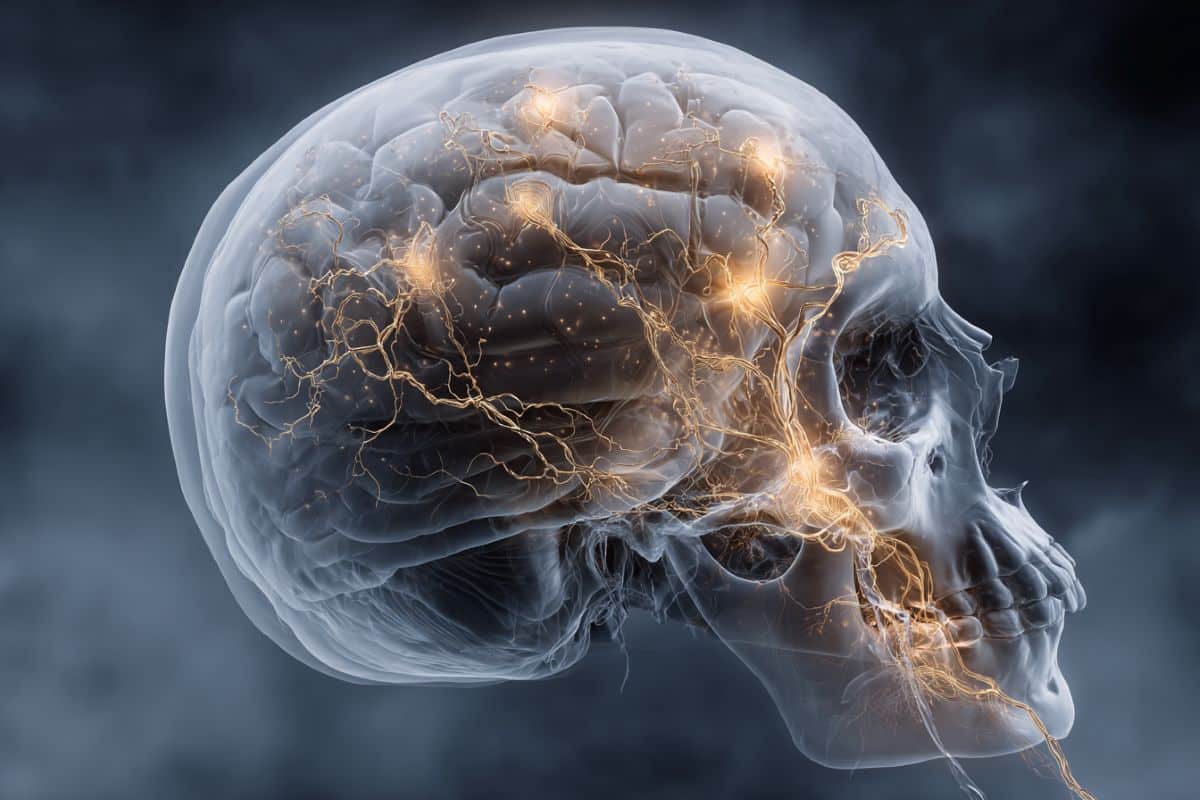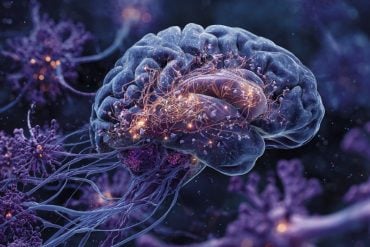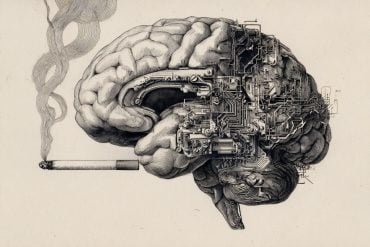Summary: Glioblastoma, the most lethal brain cancer, doesn’t just damage the brain—it erodes the skull and disrupts the immune system by reshaping marrow inside the skull. Researchers discovered that tumors increase skull-to-brain channels, allowing waves of inflammatory immune cells to flow to the cancer site, fueling its growth.
Tests in mice and patients revealed skull thinning unique to glioblastoma and immune imbalances that rendered therapies less effective. The findings highlight the urgent need to design treatments that address glioblastoma as a systemic disease rather than a purely local brain tumor.
Key Facts:
- Skull Erosion: Glioblastoma causes bone loss in the skull, particularly at sutures.
- Immune Hijacking: Tumors shift skull marrow toward pro-inflammatory cells, fueling aggressiveness.
- Treatment Challenges: Anti-osteoporosis drugs stopped bone erosion but sometimes worsened tumor progression and blocked immunotherapy benefits.
Source: Albert Einstein College of Medicine
Scientists at Montefiore Einstein Comprehensive Cancer Center (MECCC) and Albert Einstein College of Medicine have shown for the first time that glioblastoma—the deadliest form of brain cancer—affects not just the brain but also erodes the skull, alters the makeup of skull marrow, and interferes with the body’s immune response.
Drugs intended to inhibit skull-bone loss made the cancer more aggressive, according to results published today in Nature Neuroscience.

“Our discovery that this notoriously hard-to-treat brain cancer interacts with the body’s immune system may help explain why current therapies—all of them dealing with glioblastoma as a local disease—have failed, and it will hopefully lead to better treatment strategies,” said the paper’s corresponding author Jinan Behnan, Ph.D., assistant professor in the Leo M. Davidoff Department of Neurological Surgery and in the department of microbiology & immunology at Einstein, and a member of the National Cancer Institute (NCI)-designated MECCC.
According to the NCI, approximately 15,000 people are diagnosed with glioblastoma each year. The median survival of those who receive standard treatment of surgery, chemotherapy, and radiation is approximately 15 months.
A Matter of Marrow
As is true for many other bones, the skull contains marrow in which immune cells and other blood cells form. Dr. Behnan’s research on glioblastoma and the skull was prompted by recent studies revealing extremely thin channels that connect the skull with its underlying brain, allowing molecules and cells to travel between the skull’s marrow and the brain.
Dr. Behnan and colleagues used advanced imaging techniques on mice that developed two different types of glioblastomas. They found that the tumors caused skull bones to erode, especially along the sutures where skull bones fuse.
Such erosions seem to be unique to glioblastoma and other malignant intracranial tumors, since they don’t occur with strokes, other types of brain damage, or even other systemic cancers. Computerized-tomography (CT) images of patients with glioblastoma revealed that decreases in skull thickness were present in the same anatomic areas as in mice.
The skull erosions in the mice were found to have increased the number and diameter of the skull-to-bone channels. The researchers hypothesized that these channels might allow the glioblastoma to transmit signals to the skull marrow that could profoundly change its immune landscape.
A Tilt Towards Inflammation
Using single-cell RNA sequencing, the researchers found that glioblastoma had dramatically shifted the skull marrow’s immune-cell balance in favor of pro-inflammatory myeloid cells—nearly doubling the levels of inflammatory neutrophils, while nearly eliminating several types of antibody-producing B cells as well as other B cells.
“The skull-to-brain channels allow an influx of these numerous pro-inflammatory cells from the skull marrow to the tumor, rendering the glioblastoma increasingly aggressive and, all too often, untreatable,” said study co-author E. Richard Stanley, Ph.D., professor of developmental and molecular biology at Einstein.
“This indicates the need for treatments that restore the normal balance of immune cells in the skull marrow of people with glioblastoma. One strategy would be suppressing the production of pro-inflammatory neutrophils and monocytes while at the same time restoring the production of T and B cells.”
Interestingly, and adding to evidence that glioblastoma is a systemic rather than local disease, the marrows of the skull and femur reacted differently to the cancer. Glioblastoma activated several genes in the skull marrow that boosted production of inflammatory immune cells; but in femur marrow, the cancer suppressed genes needed to produce several types of immune cells.
The researchers wondered if administering anti-osteoporosis drugs that prevent bone loss would affect skull-bone erosion, glioblastoma, or both. To find out, they gave mice with glioblastoma tumors two different drugs approved by the U.S. Food and Drug Administration for treating osteoporosis.
Both drugs (zoledronic acid and denosumab) halted skull erosion—but one of them (zoledronic acid) also fueled tumor progression in one type of glioblastoma. Both drugs also blocked the beneficial effects of anti-PD-L1, an immunotherapy drug that boosts levels of tumor-fighting T cells.
The Nature Neuroscience paper is titled “Brain Tumors Induce Widespread disruption of Calvarial Bone and Alteration of Skull Marrow Immune Landscape.” Additional MECCC and Einstein authors include Abhishek Dubey, Biljana Stangeland, Imane Abbas, David Fooksman, Ph.D., Wade R. Koba, B.S., Jinghang Zhang, M.D., Benjamin T. Himes, Ph.D., Derek Huffman, Ph.D., Zhiping Wu, Rachel Welch, David Reynolds, B.S., Kostantin Dobrenis, Ph.D., Qinge Ye, Kevin Fisher, and Emad Eskandar, M.D. Other authors include Erika Yamashita, Yutaka Uchida and Masaru Ishii, at Osaka University, Osaka, Japan, Robert A. Harris at Karolinska Hospital Solna, Stockholm, Sweden, Gregory M Palmer at Duke University Medical Center, Durham, North Carolina, Olivia R. Lu and Winson S. Ho at University of California, San Francisco, CA, and Alexander F. Fiedler at German Rheumatism Research Center (DRFZ) and Freie Universität Berlin, Berlin, Germany.
Key Questions Answered
A: The cancer erodes skull bones, alters skull marrow, and disrupts immune balance.
A: Glioblastoma nearly doubles pro-inflammatory neutrophils while eliminating many B cells, worsening tumor aggression.
A: Standard therapies treat glioblastoma as a local disease, but the study shows it acts systemically, affecting skull-bone and immune interactions.
About this glioblastoma brain cancer research news
Author: Elaine Iandoli
Source: Albert Einstein College of Medicine
Contact: Elaine Iandoli – Albert Einstein College of Medicine
Image: The image is credited to Neuroscience News
Original Research: Open access.
“Brain tumors induce widespread disruption of calvarial bone and alteration of skull marrow immune landscape” by Jinan Behnan et al. Nature Neuroscience
Abstract
Brain tumors induce widespread disruption of calvarial bone and alteration of skull marrow immune landscape
The skull marrow niche has recently been identified as a reservoir that supplies the brain with monocytes and neutrophils in the context of disease and injury, but its role in brain cancers remains unknown.
Here we show that glioblastoma, the most malignant type of brain tumor, induces calvarial bone abnormalities in murine models and patients with glioblastoma, altering osteoclast activities and increasing the number of skull channels in mice.
Single-cell RNA sequencing revealed glioblastoma-mediated alterations in the immune landscape of skull marrow and femoral bone marrow, including expansion of neutrophils and deterioration of various B cell subsets.
In vivo inhibition of bone resorption reduced bone abnormalities, but promoted tumor progression in mesenchymal subtype tumors. This also abolished the survival benefit of the checkpoint inhibitor anti-PD-L1, by reducing activated T cell and increasing inflammatory neutrophil numbers.
Together, these data provide insight into how brain tumors affect skull bone and the immune environment.






